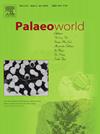埃及尼罗河三角洲新近纪古环境与油气潜力:来自一口陆上井的孢粉学证据
IF 1.7
3区 地球科学
Q2 PALEONTOLOGY
引用次数: 0
摘要
位于埃及尼罗河三角洲(东地中海)西迪萨利姆-1井新近系地层的孢粉有机质(POM)显示了从三角洲到近海海洋的广泛环境。这些环境可通过孢粉相的整体组成来区分,包括指示性鞭毛藻囊,主要是刺虫和硒藻。对中中新世(Langhian-Serravallian) Sidi Salim组近岸海洋环境进行了解释。中新世Qawasim组和上新世Kafr El Sheikh组为三角洲-浅海环境,上新世Abu Madi组为远海环境。Abu Madi组的这种较深的环境可以用来证实先前的文献,即上新世早期一个切口山谷的逐渐淹没,与迈西尼亚盐度危机(MSC)事件有关,该事件是由地中海迈西尼亚海平面下降引起的。在所研究的连续井沉积过程中存在亚氧至缺氧条件。在大部分井序列中发现了黄铁矿晶体的印记,证实了缺氧的存在。大量禾科花粉的出现可能表明该井新近纪沉积物沉积期间广泛存在干草地植被。在区域范围内,由于构造、古地理和盆地环境的影响,尼罗河三角洲地区的新近纪环境根据所调查沉积物的相对位置而变化。恢复的孢粉相在以无定形有机质(AOM)为主和以植物碎屑岩为主的类型之间波动,以干酪根ⅱ型为主,具有油气生产能力。对井段薄壁三棱孢子的孢子着色指数(SCI)的目视评价显示,其值在5 ~ 8之间,表明有机质热成熟,可能是潜在的烃源岩。本文章由计算机程序翻译,如有差异,请以英文原文为准。
Neogene palaeoenvironments and hydrocarbon potential in the Nile Delta, Egypt: Palynological evidence from an onshore well
Palynological organic matter (POM) of the Neogene succession from the Sidi Salim-1 well, located in the onshore Nile Delta, Egypt (Eastern Mediterranean), suggests a wide range of environments, from deltaic to offshore marine. These environments were discriminated by the overall palynofacies composition, including indicative dinoflagellate cysts, mainly Spiniferites and Selenopemphix. Near-shore marine environment was interpreted for the Middle Miocene (Langhian–Serravallian) Sidi Salim Formation. Deltaic to shallow marine environments were suggested for the Qawasim (Miocene) and Kafr El Sheikh (Pliocene) formations, while the distant (offshore) marine setting was established in the Pliocene Abu Madi Formation. This deeper environment, of the Abu Madi Formation, can be used to confirm a previous documentation of an Early Pliocene progressive drowning of an incised valley, related to the Messinian Salinity Crises (MSC) events, by the late Messinian sea level drop in the Mediterranean. Suboxic to anoxic conditions existed during deposition of the investigated well succession. Anoxia was confirmed by the occurrence of imprints of pyrite crystals across much of the well succession. The occurrence of abundant Poaceae pollen may suggest widespread dry grassland vegetation during deposition of the Neogene sediments of the well. In a regional context, the Neogene environments in the Nile Delta area vary according to the relative position of the investigated sediments, due to structural, palaeogeographic and basinal settings. The recovered palynofacies fluctuated between amorphous organic matter (AOM)-dominated and phytoclast-dominated categories, mostly of the kerogen type II, which is capable of producing oil and gas. The visual assessment of the spore coloration index (SCI) of thin-walled trilete spores in the well section, shows values ranging between 5 and 8, confirming a thermally mature organic matter and, consequently, can be potential source rocks.
求助全文
通过发布文献求助,成功后即可免费获取论文全文。
去求助
来源期刊

Palaeoworld
PALEONTOLOGY-
CiteScore
4.00
自引率
5.90%
发文量
95
期刊介绍:
Palaeoworld is a peer-reviewed quarterly journal dedicated to the study of past life and its environment. We encourage submission of original manuscripts on all aspects of palaeontology and stratigraphy, comparisons of regional and global data in time and space, and results generated by interdisciplinary investigations in related fields. Some issues will be devoted entirely to a special theme whereas others will be composed of contributed articles. Palaeoworld is dedicated to serving a broad spectrum of geoscientists and palaeobiologists as well as serving as a resource for students in fields as diverse as palaeobiology, evolutionary biology, taxonomy and phylogeny, geobiology, historical geology, and palaeoenvironment.
Palaeoworld publishes original articles in the following areas:
•Phylogeny and taxonomic studies of all fossil groups
•Biostratigraphy, chemostratigraphy, chronostratigraphy
•Palaeoecology, palaeoenvironment and global changes throughout Earth history
•Tempo and mode of biological evolution
•Biological events in Earth history (e.g., extinctions, radiations)
•Ecosystem evolution
•Geobiology and molecular palaeobiology
•Palaeontological and stratigraphic methods
•Interdisciplinary studies focusing on fossils and strata
 求助内容:
求助内容: 应助结果提醒方式:
应助结果提醒方式:


